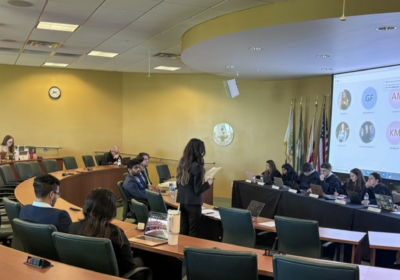Drive is a fierce and emotional heist picture
Danish director Nicolas Winding Refn isn’t a new face in the world of film. Having helmed acclaimed dramas like the “Pusher” trilogy and 2008’s “Bronson,” Refn has made a brand out of his penchant for rapid-fire editing, dark humor and unforgettable atmosphere.
All of that comes into play, along with some new flourishes, in his first American-produced film, “Drive.” From the film’s opening sequence – a high-speed chase through the fluorescent streets of Los Angeles – it’s clear that Refn has his fingers firmly on the audience’s pulse.
“Drive” follows a Hollywood stunt driver who’s simply credited as Driver (Ryan Gosling). He begins to form a relationship with his neighbor Irene (Carey Mulligan), who has a child and a husband currently in prison for gang-related crime. While Irene’s husband is in prison, Driver comes to care for her family. When her husband Standard (Oscar Isaac) is released from prison, complications ensue.
Driver’s nature is in the tradition of Clint Eastwood’s “The Man with No Name” from Sergio Leone’s Western trilogy. This character archetype is of a man who seemingly drifts through life with no real direction, occasionally reaching out to characters like Irene in an attempt to protect or help them in some way.
Ryan Gosling, who continues to prove himself as a dynamic actor in films like “Blue Valentine” and “Crazy, Stupid, Love,” walks out of “Drive” serving Eastwood’s legacy proud. While little is known about Driver, both Gosling and Refn make it clear that his intentions are good, even if his actions aren’t.
It’s clear that Refn is a fan of American film directors like Martin Scorsese, Brian De Palma, and even “To Live and Die in L.A.” director William Friedkin. While some of the more shockingly violent scenes are reminiscent of Scorsese’s work in “Goodfellas” or “The Departed,” the way in which Refn approaches suspense is more in line with the work of someone like De Palma.
From the carefully choreographed crash sequences that scream De Palma’s classic 1981 thriller “Blow Out,” to the cinematography that bathes L.A. in crisp sunlight in a way that hasn’t been seen since a film like “To Live and Die in L.A.,” it’s clear that Refn prefers the sort of gaudy thrillers Hollywood used to make.
A large part of the film’s successful suspense sequences should also be credited to composer Cliff Martinez. His ethereal electronic score becomes a part of the film’s action, sounding akin to a Pino Donaggio score found in De Palma films like “Body Double” and “Carrie.”
If there are any faults in “Drive,” they rest squarely on the film’s script by Hossein Amini. While consistently impressive, especially when considering the tense love triangle that brews between the film’s three leads, it often falls on some heist genre tropes that feel all too familiar. For instance, both Ron Perlman’s Nino and Albert Brooks’ Bernie characters are played masterfully by their respective actors, but occasionally they come off as carbon-copy villains who have been seen before.
The most intriguing and entertaining aspect of the film, apart from Refn’s showy action sequences, is the relationship between Driver and Irene. Typically scored to an ’80s-sounding ballad like College’s “A Real Hero,” Driver wishes to have Irene but can’t – fueling many of the choices he makes in the film while keeping it engaging for the audience throughout.
Refn makes a show of his first outing in America, along with a star-studded cast of actors clearly enjoying their time on screen. This is one of the few films this year that really feels like something new and special. Whether it is racing through the streets of L.A. to Kavinsky and Lovefoxxx’s “Nightcall” or Gosling sweeping Mulligan off her feet, Refn frames it all in an austere beauty that really resonates.
While directors like Hong Kong-born John Woo came to the Hollywood hills and made heaps of money, but lost their credibility on films like “Face/Off” and “Mission: Impossible 2,” Refn holds tight onto the reins of his time spent as a budding auteur.






